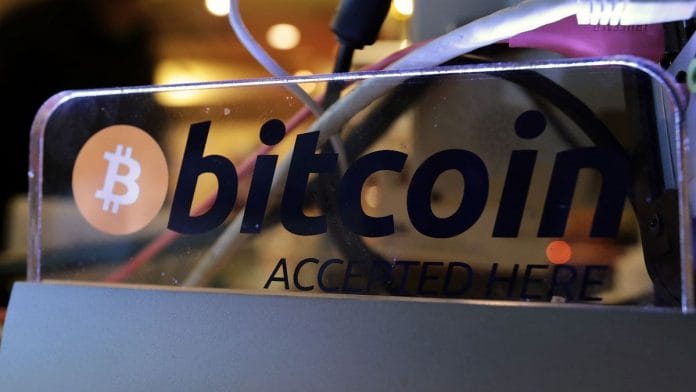New Delhi: Bitcoin, the world’s most popular cryptocurrency, gained nearly 300 per cent in 2020, with its value surging past $30,000 for the first time Sunday, up from $7,200 at the start of the last year.
Bitcoin isn’t an exception. The world’s second-largest cryptocurrency, Ethereum gained 465 per cent in 2020 too, as more and more investors poured in more and more money into the cryptocurrencies.
So why did cryptocurrencies become so popular in 2020? Is this peak sudden and temporary? How is the value of cryptocurrencies determined? Here’s a look at answers to these questions.
What is a cryptocurrency?
There are more than 2,100 recognised cryptocurrencies in the world. In this report, the focus will be on Bitcoins, the world’s first cryptocurrency.
Bitcoin was introduced by Satoshi Nakamoto, a name presumed by the developer/s of a protocol used in Bitcoin, in 2009. The physical appearance of this person/group is unknown.
It was created as a decentralised network that determines the value of currency, instead of centralised banks. The financial crisis of 2007-08 was a motivator in the creation of such a network.
Nakamoto has been quoted as saying, “Banks must be trusted to hold our money and transfer it electronically, but they lend it out in waves of credit bubbles with barely a fraction in reserve.”
The faith in cryptocurrency is based on the idea of a network that holds the currency on a blockchain, which is quintessentially a chain of transaction memories (block) on a ‘trustless’ network. A blockchain ensures transparency since every computer on the system maintains its own record of transactions, which is then compared against the records of others.
This ensures there’s no duplicity of transactions, which was always a concern in the development of digital currencies which have no physical presence.
Traditional currency is derived by the value a government assigns to it. The government can withdraw its guarantee of a piece of paper overnight, like in 2016. It’s challenging to do that with cryptocurrencies since it will require agreement from at least 51 per cent of participants on the network. Its value can’t be reduced arbitrarily by a single institution.
Also read: 2020 saw cryptocurrencies like Bitcoin gain momentum in India, thanks to male millennials
How is the value of Bitcoin determined?
The value of Bitcoins is determined by a basic demand-supply function in the market. Its supply isn’t unlimited and has been capped at 21 million, which means there cannot be more than 21 million units of Bitcoin in the world.
These units are released into the network slowly. Currently, there are more than 18 million Bitcoins in circulation. On average, a new block worth 6.25 bitcoins is added every 10 minutes.
New Bitcoins are added to the blockchain network through a process called mining, which is a way of updating the transactions on the blockchain. “One way of understanding it is to imagine paying someone a salary for ensuring your accounts books are updated. The salary is the Bitcoin reward, and the person is the miner,” explains Vikrant Mehra, marketing executive at Zebpay, which helps people trade in cryptocurrencies.
Mining isn’t easy, though. “The process of mining involves calculating a massive number (called proof of work), which can only be done with high-end processing power,” Mehra explains.
Why did value of cryptocurrencies soar in 2020?
As explained above, the value of cryptocurrencies is determined through a basic demand-supply function. There were simply too many people interested in buying cryptocurrencies and investments were pouring in.
An important point to note is that even though the supply of Bitcoins increases every day, Bitcoin units available for sale today are less than in 2017, limiting its availability.
Many experts believe the pandemic also contributed towards the massive investor confidence in Bitcoin since traditional assets lost value in the year.
Corporate investment also saw a big surge, and companies now own approximately 4.5 per cent of the world’s Bitcoin supply, valued at 4.5 million dollars. Square, an American merchant services aggregator invested 1 per cent of its total assets into Bitcoin is one such example.
Also read: The big court cases that will determine fortunes of Indian banks in 2021
Increasing acceptance
From a fringe asset, with a reputation of holding value only on the dark side of the internet, Bitcoin is being regularised by governments, slowly being accepted as a mode of payment, and is gaining respect as an asset of the future.
In India, the acceptance has increased manifold since 2017. An inter-ministerial committee formed in 2017 had suggested banning cryptocurrencies and criminalising any activity related to them. The committee had noted that cryptocurrencies are private and created by non-profits with no intrinsic value as such. It said the currency has no nominal value, and cannot be a medium of exchange. It noted extreme fluctuations in its value.
After this on 6 April 2018, the Reserve Bank of India (RBI) issued a circular barring any RBI-regulated entities from trading in cryptocurrencies. However, this circular was quashed by the Supreme Court, calling it “disproportionate”.
The Government of India has now floated the idea of regularising Bitcoin transactions by levying an 18 per cent GST on them and has even mulled the idea of introducing its own cryptocurrency.
In another development, PayPal has also announced that it will allow the use of Bitcoin and other cryptocurrencies. Customers will be able to buy and sell Bitcoin on PayPal’s platform and even use them for transactions with PayPal’s 26 million merchants, which will aid in the mainstreaming of cryptocurrencies.
“With more than 340 million users on its network, PayPal brings crypto to an entirely new segment of potential investors. For context, Bitcoin currently has 32 million non-zero addresses, 5 million of which are active,” Mehra adds.
Also read: SEBI fines Mukesh Ambani, Reliance Rs 40 crore for breaking share-trading rules in 2007






